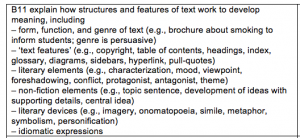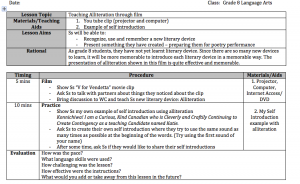LLED 368 Oct. 10 LP for Film/TV Presentation
Film/TV are wonderful resources tailor-made for the classroom, if the teacher has a specific, well defined frame/objective, as both genres are massively diverse offering almost too much choice! Visual texts demand a lot of tacit cultural/intellectual/conceptual/semantic fluency and in order to critically decode them, students need careful, attentive scaffolding.
The goal is to make the viewing of film/TV – typically a rather passive experience in many classrooms – as engaging, relevant and practical in terms of the specific learning outcomes we teachers must address (detailed below in the section on the PLOs). More specifically, Katie and I split the presentation in two, the first part on visual rhetoric, Defamiliarization and fidelity discourse for Grades 11/12, the second part demonstrating alliteration for Grades 8/9.
We suggest awareness of visual grammar will assist students in understanding and engaging in a critical analysis of film/TV (and played a Vimeo clip entitled “A demonstration of visual rhetoric in time-based media” as both a hook and illustration of the conceptual principles students should be asked to internalize).
We must model for students a critical stance when viewing. Awareness of how a film/TV producer manipulates the viewer vis-à-vis the characters, objects, or events in an image, including most importantly the image sequencing that we call “montage”, to elicit responses that have been conditioned by the viewer’s experience of equivalent interrelationships with real-life people, things, and actions. These specifically filmic devices (dramatic close-ups, zoom-ins to significant objects, low angles of important people, and so forth) are seemingly obvious, but the authors of the readings cited for this presentation suggest that quite the opposite is true, that not all students are “digital natives” in the critical sense we must require of them.
In fact this critical sense we are referring to is important since “the long term Hollywood trend has been increasingly to avoid the use of conventions like fades and dissolves to explain the transition from one scene to the next, to rely on the viewer’s ability to intuit/parse the implied relationship between scenes on the basis of contextual cues”, presumably because the public’s increasingly visually literate… but more likely this is because the seeming transparency of visual representation makes the task of criticism more difficult.
Another key component of teaching film/TV is to empower students to create their own digital videos. This way they are more than passive consumers, for as producers they will have opportunities to “discover, reflect on, and reinterpret their identities and experiences, and “understand how media acts as a frame and a filter on the world while appearing as a clear window”. A film’s “mode of address” operates from an ideological standpoint, inviting the viewer to take up particular kinds of physical, social, and ideological involvements in the unfolding of the film’s discourse, and when the student wrestles with the mechanics of creating a visual text, he/she must determine how the viewer is to be manipulated by physical space (via positioning of camera), social space (via setting and format), and an ideological space (via the seemingly “natural” visual semantics we have imbibed since childhood).
The activities were meant to model how film/TV can be used in the classroom to teach a critical visual literacy, in particular how auteur film can be sued to illustrate the literary theory of Defamiliarization, a figurative technique employed by artists/writers/directors to refashion the familiar “strange”. We took out the first activity as we were pressed for time, but I have included it here as a means of furthering your own thinking about how to do it.
– Watch opening scene from Mulholland Drive
– Discuss in small groups a hypothetical plot/ending based on what was seen
– Watch last scene
– Regroup to discuss how it differs from your first group’s plot/end
The opening scene has a wannabe young blond actress from Canada being sent off by loving grandparents arrives to LA wide-eyed full of hope; the closing scene has same actress shoot herself in a dingy run-down apartment while being terrorized by her demonic grandparents.
The second activity was meant to illustrate how auteur cinema can also violate commercial film’s narrativistic conventions.
– Watch nightmare scene from Mulholland Drive
– Discuss/write hypothetical scene resolution
– Watch the end of the scene
– Regroup to discuss the end and how it differs from your first group’s hypothesis
In the this scene a young man admits nightmare fears to psychologist who gets him to confront the nightmare by actualizing the nightmare; at the end of the scene however the man has a heart attack when nightmare becomes “reality”. Most films/TV are commercially driven imperatives framed narrativistically with a relatively fixed semantic and syntactic visual logic, but there is a long tradition – in fact preceding Hollywood’s narrativistic conventions – in auteur or ‘avant-garde’ film, of violating those conventions.
The final video clip was Mulholland Drive’s director David Lynch on how he approaches the creation of a film. His view is that the mechanistic three act structure of typical screenplays kills the “idea”, the experience he wants to convey, and goes on to suggest that talk of theme is beside the point as that presupposes there are better interpretations rather than just endless opportunities to re-interpret, a much more open-ended way to think about teaching film in our opinion. So naturally we went on to ask what people thought about relying solely on “ideas” versus a rational, mechanical construction of plot.
We ended the first part of the presentation with a short discussion of fidelity discourse in adaptations for film/TV. To quote from Bortolotti et al, “The manifest ubiquity of narrative adaptations in contemporary culture notwithstanding, the critical tendency has been to denigrate them as secondary and derivative in relation to what is usually (and tellingly) referred to as the ‘original.’”
We pulled the following quote from a LP from the Web created by Lisa Owens comparing Poe’s “Pit & Pendulum” with Roger Corman’s 1961 film adaptation:
“Close the session by saying, “Come to our next session ready to discuss both the story and the film. We’ll summarize them and talk about your preferences-which one you like better, reasons one seems to work better than the other, whether you think too much creative license was taken in the film version, and so on.”
The implication being the film should have taken into account the ‘fidelity’ to the original as an aesthetic given. We then moved to open the topic up for discussion by asking about Lisa’s commitment to “fidelity” as opposed to the interrogation of this notion in the Bortolotti et al article.
Finally, film and TV as genres are referenced specifically on page 131 section B3 in the BC Ministry of Education IRP concerning ELA. Students are to view “both collaboratively and independently, to comprehend a variety of visual texts” including amongst others “film and video” and “student generated material”. We also decided to include the following PLOs on pages 135 and 223 sections B9 and C8 as students in the course of class activities and homework assignments should be asked to “interpret and analyse ideas and information from texts, by examining and comparing ideas and elements within and among texts, identifying points of view, identifying bias and contradictions, making comparisons to other ideas and concepts, relating reactions and emotions to understanding of the text, and suggesting contextual influences and relationships.”
The resources I used in my part of the presentation were as follows:
A demonstration of visual rhetoric in time-based media
Two clips from Mullholland Drive, from .30 to 3.25 for Activity 1 and from 11.50 to 14.35 for Activity 2
A clip from an interview of David Lynch
Lisa Owen’s LP
http://www.readwritethink.org/classroom-resources/lesson-plans/comparing-literary-work-film-1048.html?tab=4#tabs
Potential lesson plan FilmtvLP
……..
The second activity began with watching the clip from ‘V for Vendetta’ where V introduces himself. It is expected that students may not know the term ‘alliteration’ but they will notice that most word begin with a V. Once students have a chance to discuss what they noticed about the clip, they are asked to try to make their own introduction using as much alliteration as possible. Of course, students are welcome to use dictionaries and thesaurus. Finally, Students were then asked to present their introduction if they felt comfortable. It was suggested after the activity finished that it might be better to have students write an introduction for a peer so that students did not have to deal with the discomfort of talking about themselves in front of a large group.
The following is an image of the lesson plan outline, step-by-step:
To create my lesson I checked the BC curriculum for ELA in elementary school and learned that students would not have learned the majority of literary devices. This is a photo of the PLOs from the ELA curriculum in grade 7. (section B11, page 4)

(Ministry of Education, Grade 7 PLOs, P. 4)
……..
Some further resources regarding the teaching of film and television in secondary schools:
http://www.filmeducation.org/teachingtrailers/secondary/
http://www.filmlit.ca/main.html
http://mediateacher.squarespace.com/film-teaching-guides/
WORKS CITED
Boggs, Joseph M., Petrie, Dennis W., (2004). The Art of Watching Films. 6th Edition. New York, NY. McGraw Hill.
Bortolotti, Gary R., Hutcheon, L., (2007). On the Origin of Adaptations: Rethinking Fidelity Discourse and “Success” Biologically. New Literary History. 38(3), 443-458.
Ehses, H. and Lupton, E. (1988). Rhetorical Handbook: An illustrated manual for graphic designers. Design Papers. 5: 1-39.
Farmer, Lesley S.J. (2007). I See, I Do: Persuasive Messages and Visual Literacy. Internet @ schools, 14(4), 30-33.
Gainer, Jesse S., (2010). Critical Media Literacy in Middle School: Exploring the Politics of Representation. Journal of Adolescent & Adult Literacy. 53(5), 364-373.
Hudson, Jennifer A., (2004). “No Hay Banda, and yet We Hear a Band”: David Lynch’s Reversal of Coherence in Mulholland Drive. Journal of Film and Video. 56(1), 17-24.
Messaris, P. (1998). Visual Aspects of Media Literacy. Journal of Communication. 48(1), 70-80.
Ministry of Education (2007). English language arts 8 to 12: Integrated Resource Package 2007. Ministry of Education.
Ministry of Education (2007). Grade 7 PLOs. Ministry of Education.
V for Vendetta. Dir. James McTeigue.” Warner Bros.: 2006, Film.
Wall, A. (2009). On Defamiliarization. Myth, Metaphor and science. (1 ed., pp. 20-22). Chester: Chester Academic Press.


0 responses so far ↓
There are no comments yet...Kick things off by filling out the form below.
You must log in to post a comment.